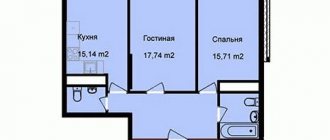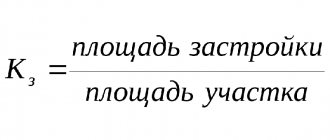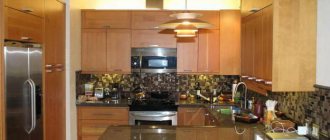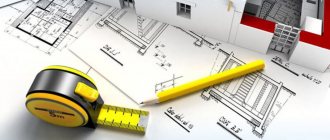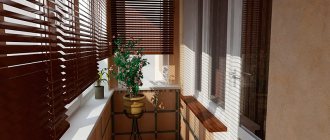At the same time, in addition to tricks with underestimating the area of the apartment at the stage of signing the contract and increasing it as a result of construction, developers (including in Moscow and the Moscow region) often deceive their shareholders by making unreliable measurements of the area of apartments and apartments and indicating an area larger than it is. actually there is. Sometimes the difference is only “one meter,” but sometimes it reaches 5–10 meters, depending on the area of the property. Multiply this added fictitious area by the cost per square meter - and you will understand the economic sense of carrying out independent measurements when accepting an apartment in a new building.
- Why measure the area in an apartment?
- The legislative framework
- Common and living space: what's the difference?
- What is included in the total area?
- What is not included in the total area?
- How to correctly measure the total area?
- Features of calculating OP for rooms of different shapes
- Calculation of the area of a rectangular room
- We calculate the area of a complex shape
- Measuring the area of additional premises
- What is a reduction factor?
- Balcony or loggia?
- What does the total area affect?
- What to do if discrepancies are identified?
- How to buy housing in a new building without risks and overpayments?
Legal consultation
The key parameters that people pay attention to when purchasing an apartment include the total area. How is it calculated? What knowledge will you need for this? Let's talk about this, as well as what rules need to be followed when making calculations, and where to go if you find a discrepancy between the designed and actual area.
Why measure the area in an apartment?
The area value indicated in the design documentation may differ from the final one. This situation often leads to conflict situations between the developer and the buyer (interest holder). The problem can be solved in several ways, depending on the terms of the deal between the parties.
Even before signing the contract, check whether it contains action scenarios in cases where the actual area does not coincide with the design one.
- The resulting area is smaller. The measurements are carried out by BTI representatives. If they confirm the discrepancy, the developer returns part of the amount paid by the buyer for the property.
- The resulting area is larger. In this case, the buyer will have to pay. He will not be able to receive a full package of documents for the apartment until he makes up the difference.
Some developers offer another solution - they install a certain “corridor”. If the deviation is within its scope, the difference is not compensated. But in such situations, buyers are often the losers.
Normal temperature in an apartment for children's health
The optimal temperature regime in the apartment is one of the necessary conditions for the proper development of children. The air temperature in the house is especially important for newborns. Their thermoregulation mechanism is not fully developed, so infants are very sensitive to temperature changes. However, you should not be afraid of the cold. A child can be overheated, and this also does not benefit his health.
Doctors consider the most optimal temperature in an apartment for a newborn’s room to be 19 – 22 degrees. If the thermometer in the nursery shows more than expected, the child is given water more often and a minimum of clothing is left on him to prevent overheating.
For children aged 1 year, the recommendations remain the same. As you grow older, the upper limit of the temperature norm is lowered.
The legislative framework
Knowledge of the laws will allow you to get out of any situation with minimal losses. If the developer has violated the terms of the contract, but does not agree to an amicable resolution of the dispute, you can safely sue him. How to find out if your rights have been violated?
Issues that relate to residential premises are regulated by the Housing Code of the Russian Federation. This regulatory act contains all the necessary information that may be required when defending your interests in pre-trial and judicial proceedings.
In addition to the Housing Code of the Russian Federation, it is worth familiarizing yourself with the following documents:
- SNiP from 2003;
- Federal Law No. 384 of December 30, 2009 (regulates the safety of multi-storey buildings).
When reading the Housing Code, pay special attention to Article 15. It is there that it is defined what the object of housing rights is. The same article contains information about what the total area is.
Note! The system for calculating the OP of residential premises is uniform throughout Russia. The classification of rooms by type is given in Article 16 of the RF Housing Code. The 17th describes the purpose of the premises, as well as the restrictions that are imposed on the use of one or another room.
Normative base
Temperature standards in residential premises are established by law. The temperature in the apartment is regulated by GOST 30494-2011 “Indoor microclimate parameters”.
According to this document, the air in each room must be heated in accordance with its functional purpose. The heat supply parameters for each room have been established. The average temperature for the entire apartment is also displayed. It is 20 - 22 degrees.
Attention! If you have any questions, you can chat for free with a lawyer at the bottom of the screen or call Moscow; Saint Petersburg; Free call for all of Russia.
Common and living space: what's the difference?
The total area is the value that is obtained by summing the footage of all rooms. The OP indicator is used when calculating utility bills, it is indicated in the purchase and sale agreement, etc.
In addition to the common area, there is also a living area, which also appears in the real estate documents. Living space is square meters intended directly for residents to live in. Let's look at the parameters by which the total and living space differ.
- Dimensional characteristics. The living area is part of the common area. Its size may be significantly smaller than the total.
- Assignment of rooms. The housing plan includes only the footage of those rooms where people spend time (children's room, bedroom, living room). The OP also includes the square footage of the sanitary unit, utility rooms, etc.
- Using values. AP is taken into account when determining the living conditions of citizens, affects the ability to receive social benefits, the amount of subsidies, etc. AP is used when calculating the market value of an apartment, calculating utility bills and payments.
People often ask what reduced area is. This value is similar to the general one. The given name is an outdated name that is not actively used today.
Who measures the area of an apartment?
Expert of the kn . kz , General Director of the appraisal Taras Mikhailovich Igashov , regarding who should officially measure your home, explains: “Appraisers do not measure the area of apartments, houses, land - legally this is not within our competence. We work directly with ready-made documents - the total and living area is indicated in the technical passport. And take measurements and calculate the area with all amendments, etc. - this is within the competence of the state represented by an organization such as BTI. And I think that's right. If you transfer the right to take measurements into the hands of independent organizations, this will inevitably lead to abuse. After all, data on the area affects the cost of the apartment, and interested parties can easily adjust them in favor of the client.”
Indeed, if we turn to the law on state registration of real estate, then in Article 18 we will see that “activities for state technical inspection of buildings, structures and (or) their components belong to the state monopoly and are carried out by the State Corporation at the location of the real estate object” .
Appraisers cannot interfere in the process of establishing the exact area of housing - the expert speaks about this unequivocally: “Sometimes appraisal companies can delicately suggest to the BTI that the area has been measured inaccurately. But we do this extremely carefully, only in a recommendatory form, and when there are really visible flaws in the measurements and calculations, says Taras Mikhailovich Igashov . — Appraisers see these flaws upon arrival at the site, comparing the numbers in the technical passport and what actually exists. There may not only be a discrepancy between the areas, but also redevelopment that is not legalized.”
You can take measurements of the area of the apartment yourself when purchasing it, for example. Especially if you see or suspect any discrepancies in the numbers and actual sizes. In addition, incorrectly indicating the area of the apartment in the documents will lead to the fact that you will need to take new measurements, redo the technical passport, etc. However, be careful - if you buy an old apartment, then the registration certificate may indicate a smaller area. It is necessary to call the surveyors from the BTI again so that they include the area of the balcony in the registration certificate.
Taras Igashov tells our readers about this nuance : “As far as I know, BTI measurers now work with a special laser ruler that accurately covers all the structural features of the rooms. In our experience, almost all documents for an apartment indicate both the total and living space. By the way, in the old technical passports the measurements of the balcony (loggia) were not included in the total area. But now balconies are also included in real estate measurements. Therefore, new technical certificates for some of our clients show a larger apartment area than before - with an increase in the balcony area.”
What is included in the total area?
Before starting the calculation, it is important to determine what is included in the OP and what is not. Let's start with the footage of which parts are included in the total area.
- Living rooms. This category includes children's rooms, living room, bedrooms.
- Kitchen. This quadrature must be included in the OP. The kitchen is considered a room for domestic and not residential purposes, although here the owner can also arrange a relaxation area or place a sofa for sleeping.
- Corridors and hallway. They connect the living rooms in the apartment with each other.
- Toilet. The area of the bathroom and toilet is added to the OP, but is not taken into account when calculating the PV.
- Wall cabinets and niches. The cabinets serve as a storage room. Niches are rare in new buildings today. They are typical for “Stalinist women”.
The area of these premises is taken into account when determining the OP of the apartment. The construction company from which you bought the property must include in the contract a plan with an accurate calculation of the footage per room.
Normal temperature in an apartment for the health of an adult
The normal air temperature in a home depends on several factors: the time of year, the region of residence, and the technical features of the home. An important criterion is the subjective preferences of a person, on which he relies when creating comfort in the house. At the same time, the standards established by experts are time-tested and based on the recommendations of doctors. Failure to follow these rules may lead to health problems.
If the room is too hot, a person feels lethargic and fatigued. Due to loss of moisture, the blood becomes thicker and the heart works harder. In people with cardiovascular diseases, their condition worsens.
In an overly warm environment, various pathogenic bacteria that can cause dangerous diseases actively multiply. In addition, constant overheating of the body, with high temperatures in the apartment, is fraught with such a dangerous condition as dehydration, as a result of which the body loses important microelements.
Hypothermia, in turn, causes constant respiratory diseases and heat exchange disturbances, and also negatively affects the human nervous system.
To maintain good health, the room should not be overheated or overcooled above the normal temperature in the apartment. The temperature norm in residential premises for an adult is considered to be 20 degrees. And to maintain sound, healthy sleep and to prevent insomnia, it is recommended to maintain a temperature of 18 degrees in the bedroom.
What is not included in the total area?
The generally accepted definition of OP is the total square footage of all rooms in an apartment. But it is not entirely accurate. There are some exceptions that are important to consider. When calculating the OP in a new building, the footage of some parts of the housing is not taken into account.
- Loggias and balconies. The legislation determines that the area of these extensions is not considered when determining the OP. Read a detailed discussion of the issue below.
- Terraces and verandas. These are extensions designed for rest and relaxation. Here you can arrange a living corner and grow plants. But when calculating the OP, their area is not taken into account.
- Niches, if their height does not exceed 1.8 meters, that is, low wall cabinets are also not considered.
- Place under the stairs. This figure applies to two-level apartments. It is not taken into account if the height of the span to the floor is less than 1.6 meters. A tape measure is used to take measurements. Measure the height at right angles to the floor.
- Fireplaces, boiler equipment and heating stoves inside the apartment. The space under these objects is not taken into account when determining the total area of the apartment, even if they are fully functional.
- Doors and arches up to 2 m wide.
If the purpose of the calculations is to determine the amount of payments for heating, the OP also does not include the area of unheated premises.
How to correctly measure the area of an apartment
When purchasing housing at the construction stage, we pay the project cost of the apartment. However, when a house is put into operation, the actual area does not always coincide with the design one. What regulations regulate the procedure for taking measurements in finished premises?
You will find answers to questions about how and what to measure in order not to make a mistake in calculating the area of finished housing in the following documents:
MINISTRY OF THE RUSSIAN FEDERATION FOR LAND POLICY, CONSTRUCTION AND HOUSING AND UTILITIES ORDER of August 4, 1998 N 37 ON APPROVAL OF THE INSTRUCTIONS ON RECORDING THE HOUSING STOCK IN THE RUSSIAN FEDERATION
3.6. Rooms are measured with an accuracy of 1 cm along the entire perimeter of the walls at a height of 1.10 - 1.30 m from the floor, with simultaneous measurement of doors, stoves, ledges and other elements, in compliance with the following mandatory rules:
door and window openings are measured in light (by curtains);
rooms separated by partitions not up to the ceiling are counted and measured as separate;
3.33. The calculation of the area of premises is carried out in explication. When making calculations, you should use values taken directly during measurements. Calculations are made with an accuracy of one decimal place.
When drawing up a formula for calculating the area of a non-rectangular room, the plan is divided into simple geometric shapes (rectangles, trapezoids, right triangles, etc.); Dimensions missing in the plan and outline for drawing up the formula are determined by the scale of the plan.
3.36. The area of an apartment in a residential building is defined as the sum of the areas of living rooms and utility rooms without taking into account loggias, balconies, verandas, terraces and cold storage rooms, vestibules.
3.37. The total area of the apartment is determined as the sum of the areas of its premises, built-in wardrobes, as well as the areas of loggias, balconies, verandas, terraces and cold storage rooms, calculated with the following reduction factors: for loggias - 0.5, for balconies and terraces - 0.3, for verandas and cold storage rooms - 1.0.
3.39. When determining the area of premises you must:
the area of niches with a height of 2.0 m or more should be included in the area of the premises in which they are located.
The area of arched openings is included in the area of the room, starting from a width of 2 m;
MINISTRY OF ECONOMIC DEVELOPMENT OF THE RUSSIAN FEDERATION ORDER dated March 1, 2021 N 90 ON APPROVAL OF REQUIREMENTS FOR ACCURACY AND METHODS FOR DETERMINING COORDINATES OF CHARACTERISTIC POINTS OF THE BORDERS OF A LAND, REQUIREMENTS FOR ACCURACY AND METHODS FOR DETERMINING COORDINATES AT OF CHARACTERISTIC POINTS OF THE CONTOUR OF A BUILDING, STRUCTURE OR UNCOMPLETE CONSTRUCTION OBJECT ON A LAND, AS WELL AS REQUIREMENTS FOR DETERMINING THE AREA OF A BUILDING, STRUCTURE AND PREMISES
12. The area of a residential premises (apartment, room) consists of the sum of the areas of all parts of such premises, including the area of auxiliary premises intended to satisfy citizens’ household and other needs related to their residence in residential premises, with the exception of balconies, loggias, verandas and terraces, exploitable roof.
The area of auxiliary premises includes the area of kitchens, corridors, baths, toilets, built-in closets, storage rooms, as well as the area occupied by the apartment staircase, and others.
The area of a residential premises includes the area of niches with a height of 2 meters or more, arched openings with a width of 2 meters or more, the floor under the flight of internal stairs with a height from the floor to the bottom of the protruding structures of the flight of 1.6 meters or more.
The area of a residential premises does not include the area occupied by protruding structural elements and heating stoves, as well as the area within the doorway.
13. The distances used to determine the area of living space are measured along the entire perimeter of the walls at a height of 1.1 - 1.3 meters from the floor.
How to correctly measure the total area?
If you plan to calculate the OP yourself, you need to understand all the nuances in detail. The total area of the apartment is the sum of all heated premises for various purposes.
Residential:
- bedroom;
- children's;
- living room.
auxiliary:
- kitchen;
- kitchen area;
- corridors;
- hallway;
- halls;
- bathroom, shower;
- restroom;
- bathroom;
- built-in pantries and cabinets, etc.
Additional:
- wardrobe;
- dining room;
- gaming;
- study;
- library, etc.
In fact, measuring an apartment is a very difficult task, the implementation of which must be approached extremely responsibly. The OP value is used when buying and selling real estate. The utmost accuracy of calculations is important. If you have never had to deal with such tasks before, we recommend using the services of professionals. They will not only take correct measurements and calculate the total area of the apartment in a new building, but will also prepare all the necessary papers. The specialists' report is a compelling argument that can be used in court. Although, if the developer reads the documents, he will not delay resolving the dispute. You can save money and nerves.
How to measure the area of an apartment?
Measuring the area of an apartment or a residential building is an important thing, because it reflects the redevelopment that has been done, and the tax is calculated based on the area. How it is calculated and what pitfalls are associated with this parameter, read on.
Features of calculating OP for rooms of different shapes
Have you decided to calculate the area of your apartment on your own? We will help you do this without errors. We suggest that you familiarize yourself with the features of calculating OP for rooms of different configurations. To work you will need paper, pencil, calculator, tape measure, laser level. Be sure to write down all obtained values. First you need to take measurements, then you can start calculating the area.
Calculation of the area of a rectangular room
The easiest way to determine the area of rectangular rooms. Let's remember geometry. To find the area of a rectangle, you need to multiply the length of its sides located perpendicular to each other. We measure the length of the two walls that are joined together. Now we simply multiply them and write the result on paper.
We calculate the area of complex-shaped premises
Not all rooms have the correct rectangular shape. There are rooms with more complex configurations. How to calculate the area in them? Likewise! First you just need to break it down into simple shapes. We work according to the following instructions:
- Print out the room plan on a piece of paper.
- We divide the existing complex figure into simple ones (rectangles, triangles), and mark the boundaries with a dotted line.
- We calculate the area for each figure separately.
- We summarize the information received - we have the area of the room.
What to do with oval-shaped rooms? Premises of this configuration are rare. To calculate the area, you also need to divide the room into triangles. There will be some space left outside these figures. But they are so small that their area will not greatly affect the final result. If any questions arise, chalk it up to an error.
Measuring the area of additional premises
Article 15 of the Housing Code of the Russian Federation clearly states that the area of balconies, loggias, and terraces is not taken into account in the calculation. But there is another document - decision of the Supreme Court No. GKPI11-1727 for 2011. This is where the requirement to add the area of these extensions to the OP is justified. The fact is that these auxiliary rooms are often quite large. To expand the living space, they are reformatted into rooms for other purposes, combined with a kitchen or living room.
The slabs and beams on which balconies and loggias are installed are important structural elements of the building. They strengthen and toughen the structure and belong to the common property of the residents of the house. Walls, ceilings, communications are shared property. But the balconies and loggias that are located on them are the property of the apartment owner. This nuance is recorded in documents from the BTI (technical passport).
What is a reduction factor and why is it needed?
A construction company spends a lot of money and time on the construction of loggias, balconies, and terraces. The demand for compensation for these expenses is quite logical. It is not the full area of these superstructures that is added to the OP, but the value obtained by multiplying the area by a reduction factor. It will vary depending on the characteristics of the room.
- 0.5 – loggias;
- 0.3 – balconies and terraces;
- 1.0 – verandas.
Why should the developer notify the buyer of an apartment in a new building about the reduction factor if he can avoid multiplying the area of these auxiliary premises and add the full value to the OP? Future owners should be familiar with all legislative nuances in order to avoid unnecessary waste of financial resources.
Balcony or loggia?
What's the difference between 0.3 and 0.5? In such numbers it is not significant. If we are talking about hundreds of thousands of rubles per square meter, then these 0.2 will play a significant role. Why should you give your money to someone? It’s better to find out everything right away in order to have a constructive dialogue with the developer and get out of the situation with maximum benefit. We invite you to familiarize yourself with the design features of balconies, loggias, and verandas.
- A balcony is an extension that protrudes beyond the outer walls of a building.
- A loggia is a part of the apartment that does not protrude beyond the boundaries of the house. The extension does not affect the natural light in the adjoining room. The depth of the loggia is limited.
- The veranda is a separate, rather large room with its own lighting.
Having one of these extensions is a big plus. They can be insulated, glazed, and a recreation area or winter garden can be arranged here. But you still have to pay for them, although not the full price.
Note! Reducing factors can be used when it comes to residential premises. If you have an apartment, you will pay full price for the loggia and balcony.
How to calculate the area of a room in square meters
The need to calculate the area often arises only during renovation work, construction or when changing furniture. Almost all building materials (for example, flooring) are calculated in square meters. To correctly calculate the amount of material, it is important to know the floor area. Knowing the width and length of the room, finding the area will not cause any difficulties.
Measurements
Before measuring a room in square meters, you need a minimum set of items:
You need to make a detailed floor plan on paper. Each wall should be measured using a tape measure.
Attention! It is very important to take measurements at floor level, because there are cases (especially in older houses) when the walls are slightly tilted to one side. Since the floor is being measured, it is necessary to measure as closely as possible to the walls.
The second stage is to put the obtained measurements on the plan. It is best to immediately do this in meters, but the accuracy of each measurement should be up to 1 centimeter. This is necessary so that when choosing the required amount of materials, it is possible to select the footage of the required material as accurately as possible. Rolled floor coverings are sold by linear metres.
Rounding can only be done if the increase is small, so that in case of unforeseen circumstances, there is a sufficient amount of material.
How to calculate the square footage of a room
To understand how to find out the total area of a room, you need to use a simple formula and multiply the length by the width. As shown in the figure, the long wall has a length of 7 meters and the opposite one is only 4. It turns out that the floor area will be equal to 28 m2. This is how the quadrature is found. It is imperative to remember the small reserve that will be required for adjustment and trimming, and the more complex the installation option, the more reserve you will need to take.
Often rooms do not have an even square or rectangular shape. Therefore, before finding out the area of the room in square meters, you just need to divide the room into several simple shapes (squares and rectangles) and then calculate the total square footage. So, for example, for a room that has the shape of the letter L, it is enough to divide it into 2 rectangles, separately calculate the area, and then add it up.
It all looks like this:
- we calculate the quadrature of a large rectangle: multiply 5 by 4.35 and get 21.75 square meters;
- now, using the same principle, the second one: 2.5 by 2.65 and we get 6.625 squares;
- then we sum up the total result 6.625 + 21.75 and get the area of the room in the amount of 28.375 square meters.
What does the total area affect?
Why such difficulties? Just think, square plus, square minus: nothing bad will happen. By the way, it is beneficial for both construction companies that sell real estate and management organizations that buyers think so. When buying an apartment, utmost precision is important. Let's look at it with an example. We will work with the following initial data:
- design area – 70 sq.m.;
- total area – 68 sq.m.;
- price per square meter – 600,000 rubles.
According to the project, the apartment costs 42 million rubles. The real price of this property is 40.8 million rubles. That is, if you measure everything and prove that the apartment is not the declared 70 sq.m., but is 68 sq.m., you will save 1.2 million rubles. For this money you can do some repair work. Let's look at what the OP affects.
- Apartment price. Pay only for the actual area. If you refuse to recalculate, you risk losing a tidy sum.
- Communal payments. When determining the rent, the OP of the apartment is taken into account. Accordingly, the larger the footage, the more you will pay for heating, home maintenance, etc.
- Major home renovation. When buying housing in a new building, future owners rarely think about renovating a newly built building. But in 10-15 years you will have to pay money for major repairs. The contribution amount is calculated based on the square footage of the apartment.
- Redevelopment. If you want to demolish interior partitions in an apartment or build them, you may encounter problems with the BTI.
The OP value also affects the comfort of living in the apartment. That is why it is so important to carefully recalculate the footage and determine the real OP.
Apartment area
Many argue that repair is a process that is almost impossible to complete, it can only be suspended. Despite this, in order not to turn a minor repair into a global one, it is very important to correctly calculate all the necessary numbers and carry out the necessary calculations, one of which is measuring the quadrature.
Now you know how to find the area of a room knowing the length and width, and after all the manipulations performed, you just need to add up the data obtained by room, then you can get the square footage of the entire apartment.
This process is required for purchasing materials. The last stage will only be the development of a plan, where all the lengths, widths of window and door frames, etc. will be indicated. This is necessary, for example, for laying floor tiles or laminate. Such a scheme will be required when laying heated floors.
There are also modern applications for smartphones or services on the Internet that will simplify these moments and help you find the area.
What to do if discrepancies are identified?
Let's say you find deviations. What to do, where to go? In most cases, the differences are minor, so the owners calmly accept the property, receive the keys and begin to carry out repair work. But you can also act in a different scenario - file a claim and demand compensation. According to regulations, there is a discrepancy of even 0.1 sq.m. – this is already a reason to start proceedings.
Whether to accept an apartment in a newly built residential building or start a dispute with a construction company – the decision is yours. Some people demand compensation after 0.1 sq.m., while others are ready to turn a blind eye to a discrepancy of 0.5 sq.m., just to quickly receive documents for the apartment. If you nevertheless decide to exercise your right to compensation for the missing apartment space, we recommend following the following algorithm:
- Submitting a claim to the developer (by a valuable letter via the Russian Post service or in person). In the document, explain that the actual OP does not correspond to that stated in the DDU, and also require repeated measurements with the participation of a cadastral engineer.
- If the developer responded positively, invite him to resolve the dispute. The most effective way out of this situation is to provide monetary compensation, that is, return part of the money paid for the apartment to the buyer. Determine the amount yourself, taking into account the difference between the projected and actual cost, as well as the price per square meter.
- If the construction company ignores the claim, conduct an examination with the involvement of experts and begin preparing documents for the court.
- The court examines the case materials and orders an independent examination. Based on the results obtained, a decision is made on the case.
What do you need to defend your interests? Impeccable knowledge of laws. If you are not well versed in all these legislative provisions, and there is no time to delve into it, enlist the support of a qualified lawyer who specializes in resolving such conflicts.
Why do you need a measurement plan?
Let's start with this question, since without an answer to it the article makes no sense at all. Why do you need a measurement plan? Some believe that a plan from the BTI or, for example, from a developer indicating the area of the rooms is quite sufficient. And they are wrong. Take a look at how the BTI plan looks schematically.
And a full “measurement”.
So why do you need measurements?
- This way you will find out how many square meters the apartment actually has - believe me, the area specified by the developer may be incorrect.
- Find out the dimensions of the walls and ceilings.
- Find out the nuances of the shape of the room (taking into account niches, columns, bay windows, the height of walls and partitions), the sizes of window and door openings and many other necessary points, which we will talk about under the “what not to forget” point.
- This will help to calculate the required amount of building materials, take measurements for the design of the future kitchen set, and arrange furniture in the future interior.
How to buy housing in a new building without risks and overpayments?
It’s not for nothing that they say: forewarned is forearmed. Even before signing the contract, check with the developer’s representatives how the total area is calculated, what is included in it, what is not included, and whether a reduction factor is used to calculate the square footage of a balcony or loggia. Of course, you don’t want to start proceedings with the developer immediately after the delivery of a residential building. To avoid conflict situations, when choosing and purchasing an apartment in a new building, consider the following points:
- trust reliable companies for the construction of residential buildings, whose portfolio already includes successfully completed projects;
- study in detail all the information about the developer, read reviews and comments about him on specialized forums;
- directly when choosing an apartment, find out all the points relating to the property, in particular, ask about the actual area and other characteristics;
- read the contract, pay special attention to the small print, it may contain information about errors and permissible deviations.
You can safely buy an apartment in a new building if you approach this issue responsibly. Increasingly, future owners are resorting to the services of real estate lawyers. Why is the help of a lawyer beneficial? A specialist in this profile is familiar with the latest innovations and has sufficient knowledge of Russian legislation. By the way, the first consultation is usually free of charge.
Even at the stage of selecting a property, a specialist will advise on construction companies and residential complexes. At the stage of registration of the transaction, the lawyer will analyze the contractual agreement and check its legal purity. And the third reason: if any inconsistencies are identified, the lawyer will make every effort to satisfy the buyer’s requirements at the pre-trial stage. If this fails, the specialist will represent the client’s interests in court.
- Support of transactions with apartments
- Lawyer services in Moscow
- Recognition of ownership of an apartment in a new building
- Claim for recognition of ownership rights
- Recognition of ownership of real estate through the court
- Recognition of ownership of real estate
- Residential building purchase and sale transactions
- Legal services for transactions with apartments
- Review of the developer of the Lyubertsy residential complex
- Apartments in new buildings on Vavilova, 4
- Apartments in new buildings Ilyinskie Luga
- Apartments from the developer "Rusich"
- Apartments in the new building Parade of Planets
- Apartments in the new building Neva Towers
- Apartments in a new building developed by the Etalon Group of Companies
show all
How to measure (measure) rooms and premises correctly?
This is not difficult to do if you follow some rules and a certain order:
Inspection of the room
First you need to carefully examine the room, paying attention to the outlines of the walls. See if there are any elements protruding from the walls (fireplace, windows, window sills, columns, pilasters, bay windows, suspended or suspended ceilings, etc.).
Photographing
The next stage of work is to take photographs of the room: one overall, then each wall, each corner, then the floor and ceiling.
First drawing
Next, you need to take an album and draw in it the location of the walls (not to scale, but approximately), marking the places where the windows and doorways are located. There is no need to try to do everything neatly and evenly at this stage - this is still the first drawing, a sketch on which you will mark the remaining measurements.
Wall measurements using a tape measure and rangefinder
You need to measure the entire length and width of the walls. In addition, you need to measure the height of the entire room and other elements. It is important to take into account the design of the ceilings, the presence of projections, columns and stairs (if any).
Measuring wall corners
If you use a laser rangefinder, then the procedure for measuring angles will not be difficult for you - just install it at one end of the room and aim it at the wall perpendicular to the plane.
However, this rule works if the room is regular, rectangular in shape. If there are obstacles in the path of the rangefinder (for example, a ledge or a column), it is better to measure these angles with a regular tape measure.
Floor area measurement
This can be done either manually (by multiplying the length of the walls by the width) or with a rangefinder. Most rangefinder models have this feature.
It is recommended to show the area of each wall separately in the drawings (this may be useful in the future in order to accurately calculate how much paint or wallpaper will be needed for a given wall).
Checking the verticality of the walls
This can be done with a building level or a rangefinder (if it has such a function). It is important that the deviation from the norm is minimal.
Checking the verticality of walls is necessary not only at the stage of construction or acceptance of a house from the developer. The fact is that uneven walls, corners or bends on them lead to inaccurate measurements, which can subsequently cause a lot of trouble when repairing or selecting furniture.
Measurements of window and door openings
It is important to measure not only the length and width of the openings, but also their height and thickness. Please also note that for the door you will need a door frame and trim, and for the window - a window sill and slopes. Therefore, it is better to measure the thickness of the wall near the door and the recess in the window in advance.
In addition, it is also recommended to measure how much the window sill protrudes from the wall: forward and to the side. This will help you choose the right radiators (batteries) in the future.
Measurements of communications, electrical wiring
Once the geometry of the room has been completely measured, you can begin measuring existing and future communications in the house. You should measure all places for sockets, switches, sconces and ceiling lights. It is necessary to know where exactly in the wall/ceiling they are or will be located.
To do this, you need to measure the height and width of the wiring to the control point (vertical and horizontal). Don't forget about the height, because even if you know that the outlet for the hood will be located 650 mm from the wall, you cannot be sure: will the hood cover the outlet or not? These measurements are most important for rooms such as the kitchen or bathroom, although they should not be neglected in other rooms either.
Then you need to measure the pipes and connection points for hot and cold water, sewerage, ventilation, air conditioning, fans, fireplace and gas pipes. Be sure to note on the drawing what equipment is connected to a given bathroom drain, because the drain to the toilet is different from the sewer or washing machine.
Measurement of radiators, batteries
When taking measurements of radiators, it is important to take into account not only their height and width, but also the distance from the wall and the height of the place above the floor. It's a hassle, but believe me, it's worth it. Especially if the rooms are small (for example, a bathroom) - it will be much easier for you to select furniture for it, knowing the exact dimensions of the radiator.
Drawing up a drawing
When all measurements are completed and photographs are taken, you can begin to draw up the final drawing and draw it carefully and to scale. You can draw it by hand or use any of the many free programs on the Internet.
That, in fact, is all the recommendations. Now you already know how to correctly measure the area of rooms and premises in your home and what tools you will need for this. Happy renovation!
Buy a laser rangefinder
Don't forget to add the Nedvio website to your Bookmarks. We talk about construction, renovation, and country real estate in an interesting, useful and understandable way.
Source
Reducing or increasing the area according to the DDU when measuring an apartment BTI
A decrease or increase in area according to the DDU when measuring an apartment in a new BTI building almost always happens. The square footage of apartments in new buildings changes after construction, and the difference between the designed and actual area sometimes reaches 5 or even 10 percent!
Measuring the area of an apartment by the BTI may indicate that the area of the apartment is incorrect. For example, the area of the apartment will turn out to be larger than in the DDU agreement, but in reality it will be less than in the DDU. Then the shareholder will have to pay extra for the extra footage according to the agreement.
The following information will clarify issues regarding the calculation of measuring the footage of an apartment in a new building in the event of disagreements with the developer and regarding the payment or non-payment of monetary compensation to the shareholder.
Differences between areas
This aspect needs to be given special importance. How is the total area of a two-room apartment determined? What indicators are taken into account? There are certain differences between the living area and the common area that should definitely be taken into account. These include:
- Number of square meters: living area is only a component of the total. For this reason, its footage should be much smaller. Sometimes these indicators may differ from each other by a factor of two.
- Premises included in the total area: living rooms include rooms for sleeping and relaxation (bedrooms, children's rooms, guest rooms). General covers all rooms in the apartment.
- Possibility of use: the possibility of receiving subsidies, adopting a child, and so on depends on the size of the living space. The total area affects the market value of housing, the amount of utility bills and the amount of contributions for major repairs.
